Last-Minute NYC Holiday Gift Guide 🎁
We’ve created a holiday gift guide with presents for the intrepid New Yorker that should arrive just in time—


A combination of a super-mall, luxury showcase, restaurant hub, and industrial office space, Chelsea Market and its bustling interior always feel a bit like the holidays. There you’ll find businesspeople sipping Intelligentsia coffee next to tourists peeling apart lobsters next to focused shoppers looking to score their next great purchase. Fountains bathed in neon light flow next to cheery bakeries and gelato shops, hip jewelry stores glitter, and unmarked doors promise the unknown.
Located next to the High Line in the center of Chelsea, the Market has many of its own stories to tell. It has an illustrious history and as many secret passageways and unsolved mysteries as you’d expect. Read on to discover the Top 10 secrets of the Chelsea Market.
Before Chelsea Market was Chelsea Market, it was the headquarters of the National Biscuit Company, also known as the Nabisco Factory. The factory officially opened in 1890 when eight bakeries came together to create one super-bakery, and continued to expand until 1958 when the corporation left the city for the suburbs.
Nabisco made everything from saltines to Fig Newtons to Mallomars to Animal Crackers. But in 1912, Nabisco invented arguably its most successful product— the Oreo cookie. Their lead food scientist Sam Porcello designed the recipe, and this as well as its design have remained essentially the same since then. The company also produced classic American products like Saltines, Vanilla Wafers, Fig Newtons, and Barnum’s Animal Crackers.
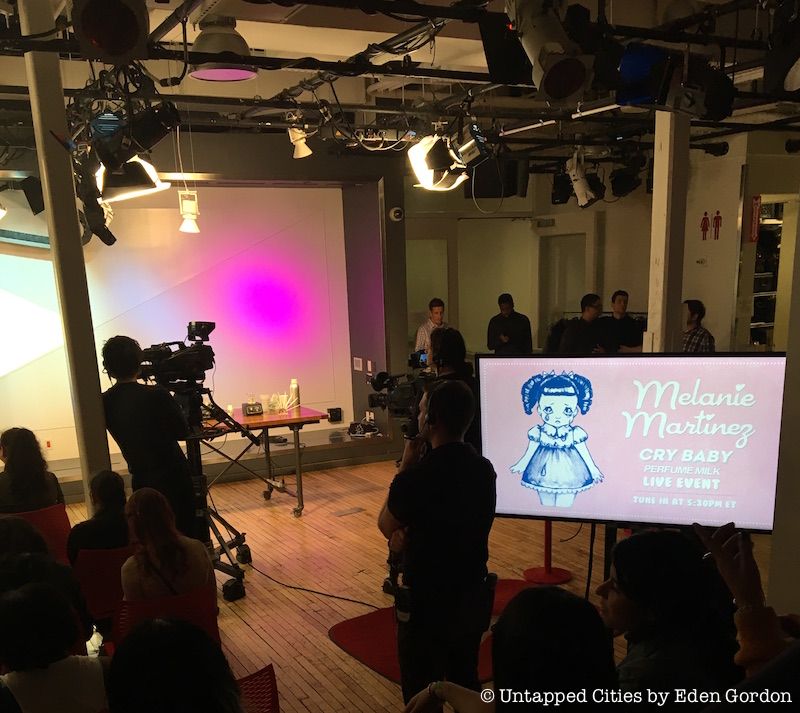
There is a certain drive and energy inside Chelsea Market, a sparkling current that seems to roam freely throughout the building. Part of this can be explained by the multitude of high-tech, multi-billion-dollar corporations that are housed inside the Market’s upper levels and hidden rooms.
One of the companies that has capitalized on the market’s prime space and location (by the Hudson River, in the midst of some of New York’s most luxurious shops and restaurants) is YouTube. The platform, which is owned by Google, receives over one billion visitors per day and streams over six billion hours of video per day. In Chelsea Market, YouTube has a 20,000-square-foot film studio for creators and innovators inside the market in 2014. The space can only be found by winding around an unremarkable corner near a coffee shop and taking a silver elevator (manned by a bouncer) up several flights (once also the way to pick up your Google Glasses). Once you get there you’ll find YouTube Space New York, one of the five spaces YouTube has opened worldwide in order to give their influential creators a luxury studio in which to film their content.
The New York studio features three sound stages, five editing stations, and even some rotating sets, including one that includes the original walls, phone booth, and cash register from legendary East Village rock venue CBGB. Creators can use the studio, which provides courses on things like audio mixing, production, and building a personal brand, if they have over 1,000 subscribers.

Photo from Library of Congress
Chelsea Market may house its fair share of new companies on the cutting edge of technology, but it still rests firmly on the foundations of its industrial past. Unfortunately, some of these foundations have a bit of a bloody history.
Also known as “The Butcher,” the freight train system that rode along 10th and 11th avenues between 1846 and 1941 killed over 436 people during its reign of terror. This was partly because the railroad had no barriers to stop people or cars from crossing the tracks. The trains ran alongside cars and pedestrians, and many casualties ensued.
In 1850, in an effort fueled by well-meaning desperation, the Hudson River Railroad recruited literal cowboys to ride in front of trains waving red flags, hoping they would wave patrons out of the way. They specifically chose seasoned Western cowboys rather than New York horsemen, reasoning that it would be too difficult for anyone but the most experienced rider to control his steed in the midst of the city’s traffic. Called the Westside Cowboys, they rode until 1941. Luckily, “Death Avenue” was shut down — but the tracks remain underneath the market.
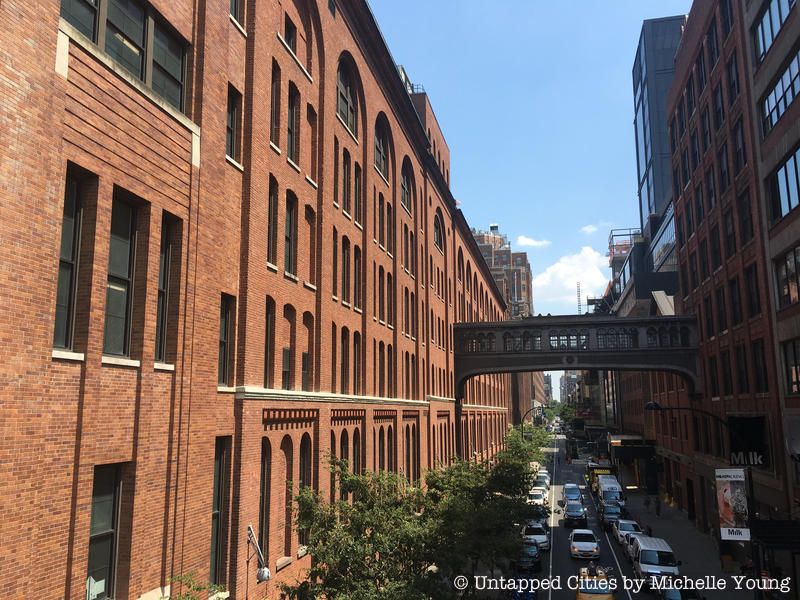
Before Nabisco, the company was the National Biscuit Company, itself a combination of twenty baking companies. In 1893, the biscuit company built a Romanesque Revival style building – the Landmarks Preservation Commission report for the Gansevoort Historic District refers to it as “stables.” By 1898, the National Biscuit Company merged with the American Biscuit and Manufacturing Company, from Chicago. They conglomerate became the largest supplier of biscuits in America. The stables expanded into quite the structure, 17 buildings in combination – most built between 1905 and 1912.
In the construction of one of the buildings in 1913, between 10th and 11th Avenue (home to Del Posto), the anchor, timbers and chain of a two-masted schooner were discovered during excavation, reports The New York Times.
After the Nabisco factory jumped ship and headed for suburbia in the 1950s, the not-yet-Chelsea Market lay empty until 1997. During this time, the market became notoriously dangerous. It is said that it was a hotspot for prostitution and there were three murders in its basement.
The buildings were purchased by Irwin Cohen in 1997, and since then it has become a glittering shopping center in the midst of a neighborhood that has seen a 38% decrease in crime since the onset of the 21st century.
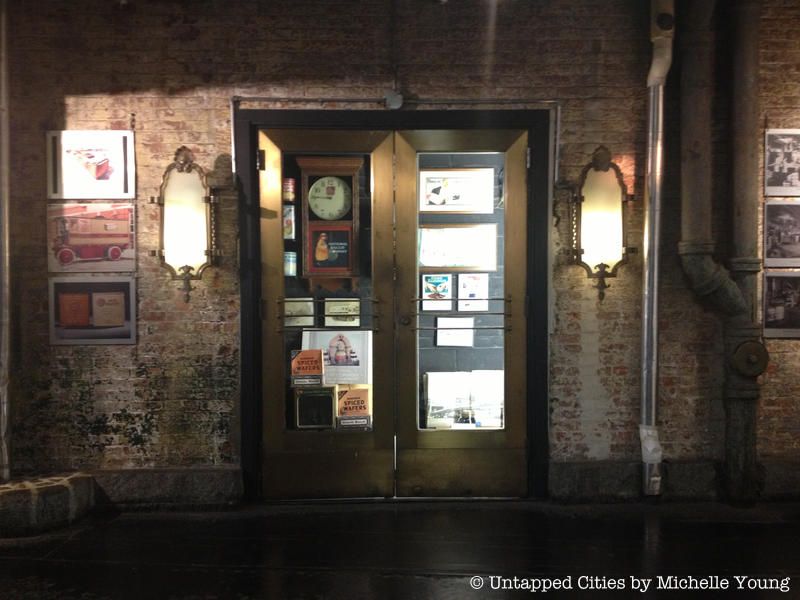
Beyond the building itself, numerous remnants of the Nabisco factory can be found within Chelsea Market. Two original murals are shown on the brick inside and display cases are dedicated to the history and artifacts of the company. Find out more places to spot them here.
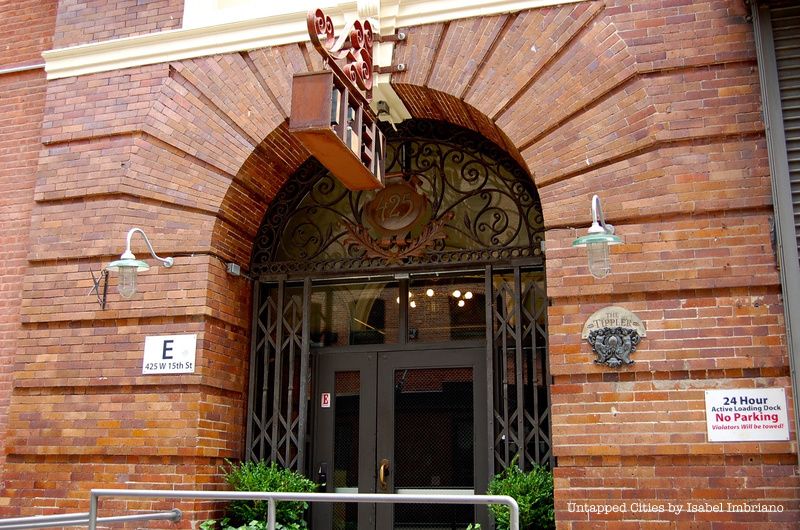
The Tippler is a hard restaurant to find if you don’t know what you’re looking for. Located at the bottom of a spiral staircase on West 15th street, in between a lumberyard and an auto repair shop, it is a pop of gilded luxury hidden under the earth. Its design riffs on the Market’s industrial past, retaining some of the original brick and iron while adding colorful fairy lights and a well-stocked bar.
There’s a lot of incredible food in the Chelsea Market, though, so don’t fill up too much at any one particular spot. You can get toasted cheese from Lucy’s Whey, chicken pot pie at Green Table, gelato at L’Arte de Gelato, and about a million other things.
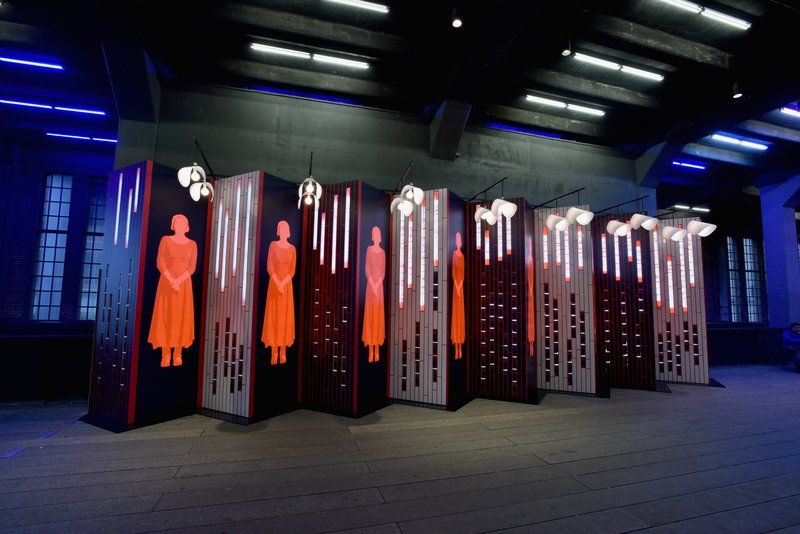
A view of an art installation, designed by Paula Scher and Abbott Miller, and book giveaway celebrating Hulu’s ‘The Handmaid’s Tale’ opened on the High Line on April 26, 2017 in New York City. Photo by Bryan Bedder/Getty Images for Hulu
If Chelsea Market were a person, she’d probably be a total foodie and shopping addict. The High Line would be its slightly earthier partner in crime. In April, the Chelsea Market passage on the High Line was the site of an installation based on the new Hulu series “The Handmaid’s Tale,” after the book of the same title by Margaret Atwood.
The installation gave out 4,000 free copies of the book, which many have turned to in light of American politics. The books were stored inside a red wall that also displayed the message, “Nolite te bastardes carborundorum,” a fake-Latin phrase that means “don’t let the bastards grind you down” in the book.
Another great art installation that has unfortunately left the High Line is Spencer Finch’s famous The River That Flows Both Ways. This installation, made of 700 panes of glass that represent the Hudson River over the course of 700 minutes, was the High Line’s longest-running, having already been installed when the High Line opened in 2009.
The Chelsea Market passage is the 5,900 square foot walled section of the High Line that can be used for sit-down arts events and affairs. It leads you right from the High Line into the Chelsea Market.
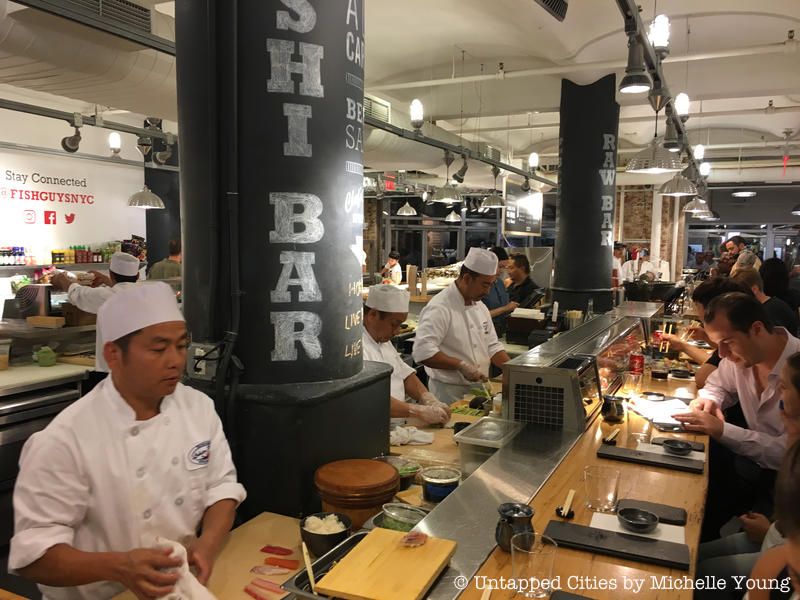
The Lobster Market inside Chelsea Market has a 20 seat sushi bar – that just opened for breakfast in addition to lunch and dinner this year. The sushi bar is inspired by the fresh fish extravaganza at Tokyo’s Tsukiji fish market, which opens before dawn. You can get a a $68 omakase (set order determined by the sushi chef) or a la carte.
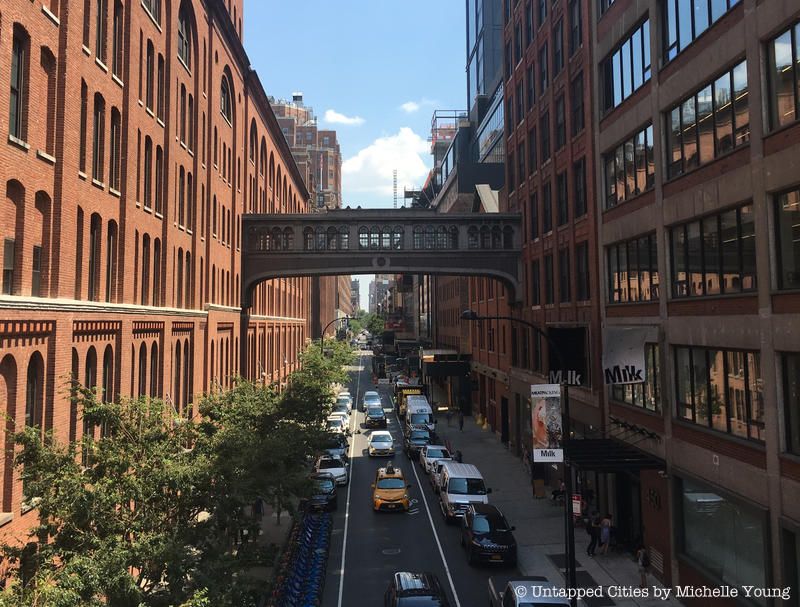
For fans of elevated walkways, Chelsea Market has two sky bridges – one spanning 15th Street and one spanning 10th Avenue. The 15th Street one is clearly of an earlier time period, likely when the Romanesque main structure was built. The New York Times surmises that the aluminum Art Deco one below was completed in the 1930s, when the Nabisco Company staff architect Louis Wirsching Jr. redesigned the bakeries along the 10th Avenue side, adding the freight run through that is now home to art installations and vendors.
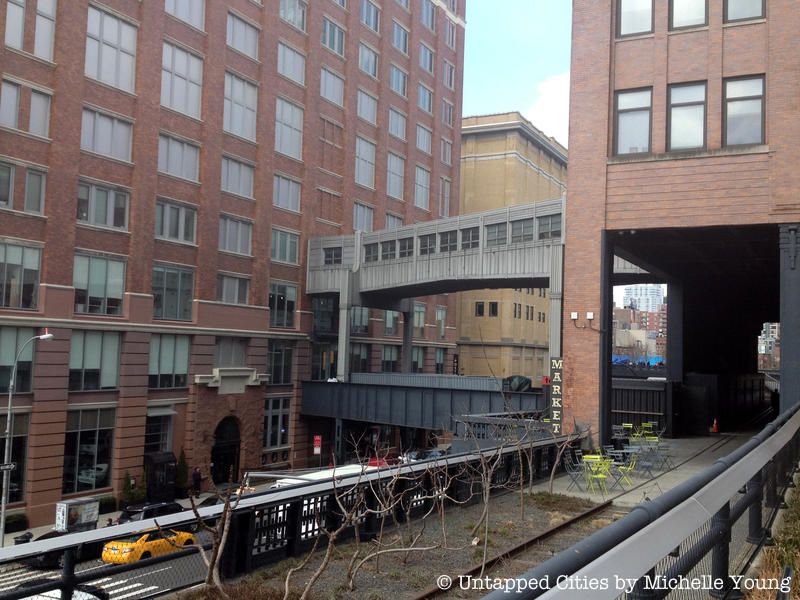

Chelsea Market’s current design scheme pays tribute to its industrial past in a uniquely authentic fashion. Instead of utilizing a minimalist, modern design scheme, like so many shopping malls have, the Market’s designers created a space that reflects the market’s industrial roots and preserves its vintage feel. The lobby entrance from 9th Avenue contains an artistic display of industrial finds from cast iron lampposts to the .
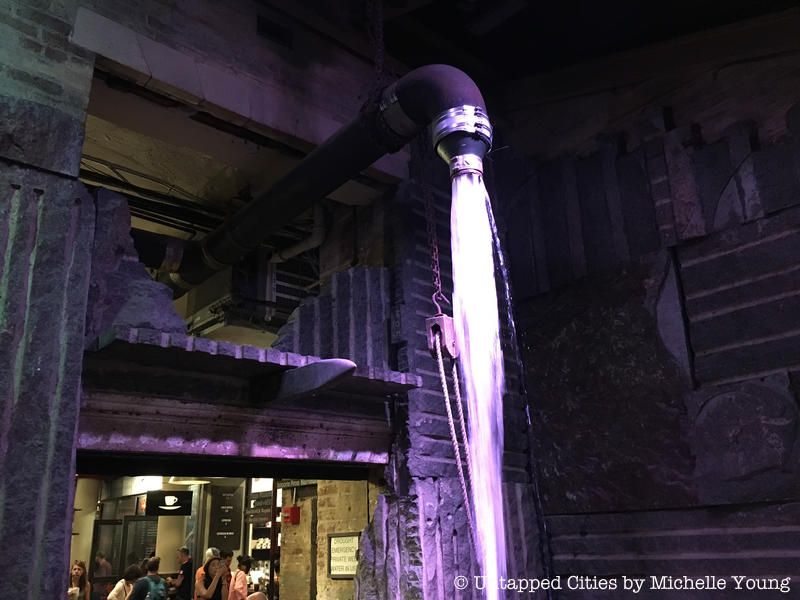
The market’s past is especially visible in the Chelsea’s Pipe Fountain, which spews colorful illuminated water at all hours of the day and night. The fountain was made of discarded drill pieces and pipe fragments. The Market and its fountain are successful examples of urban recycling done right—instead of destroying all remnants of the past and then creating something new, pieces like the fountain preserve its legacy by using materials that already existed.
This was a deliberate gesture by Chelsea Market investor Irwin B. Cohen and building designers Vandeberg Architects. Cohen tells The New York Times his aim was “to show New York that this was like the excavation of a mining site.”
Chelsea Market is a place like no other, and it’s easy to get lost in its winding maze of stores, shops, patisseries, and so much more. If you’re lucky, you might run into a star on their way to the YouTube space, or a future billionaire on the way to her internship at Google. Even if you don’t, Market is a celebration unto itself, a symbol of New York’s recent stratospheric spike in growth and wealth and an example of consumerism and innovation at their most extravagant.
For more, check out the Untapped neighborhood guide to Chelsea and this article about 10 of NYC’s oldest historic restaurants, inns, and taverns.
Subscribe to our newsletter